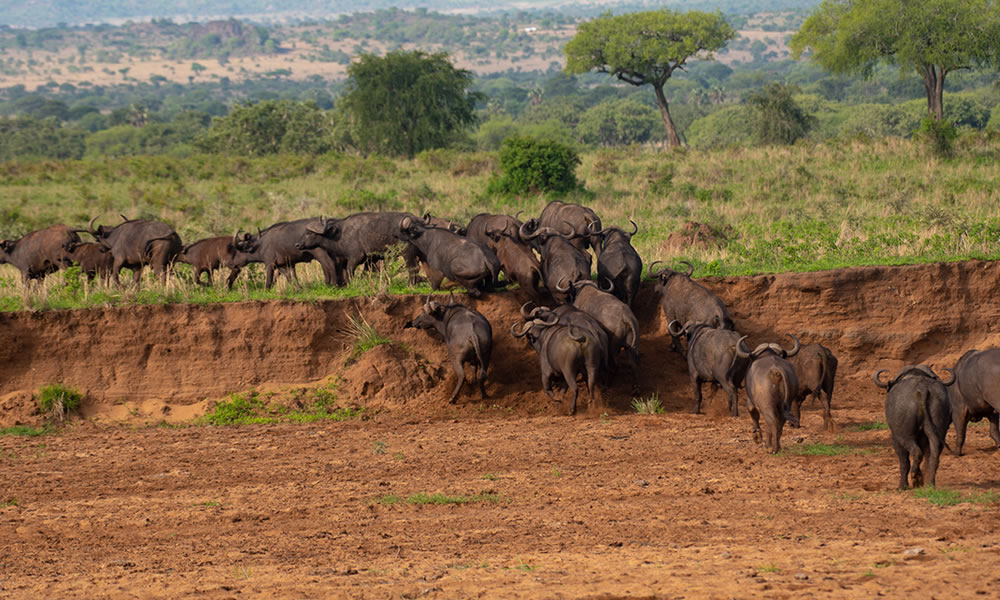Kidepo Valley National Park is located in the Kaabong area of northeastern Uganda. The settlement of Kabong is located close to the South Sudanese border with Uganda. This secluded and distant national park is primarily made up of large valleys, hills, and untamed Savannah that are encircled by the Morungole Mountains. In an effort to reduce the amount of Tse Tse flies in the park at the time, the Ik and Dodoth engaged in excessive hunting and destroyed vegetation, leading the colonial authorities to turn Kidepo into a wildlife reserve in 1958. The wildlife reserve was transformed into Kidepo Valley National Park in 1962, four years later. Uganda gained its independence in 1962.

Narus and Kidepo are the two main valleys in the park. At the heart of each of these valleys is a river bearing the same name. During the midst of the dry season, the Narus and Kidepo rivers dry up, leaving the animals to live on the few surviving tiny ponds (oasis).The combination of Kidepo’s semi-arid climate, mountains, plains, Savannah grasslands, and wildlife make it Uganda’s best park in terms of scenery. Because so much wildlife congregates in one place, Kidepo is also the best national park for wildlife viewing. Kidepo is one of the top three national parks in the world according to CNN Travel.
The wildlife of Kidepo National Park includes species like maneless zebras, ostriches, orcas, cheetahs, and wild canines that are unique to Uganda and cannot be found in any other national park. Aardwolves, buffalo, caracals, jackals, Klipspringers, elephants, giraffes, hyenas, bat-eared foxes, leopards, and lions are among the other species. Bohor reed buck, bush buck, bush duskier, defassa water buck, eland, Jackson’s hartebeest, kudu, reedbuck, Uganda kob, and oribi are among the antelope species.
Things to do in Kidepo Valley National Park
Game Drives
The majority of visitors come to Kidepo on safari in order to see the animals and engage in other popular park activities. The best game drives in Uganda may be found near Kidepo. This is mostly due to the enormous number of animals and birds that congregate in the park’s large valleys for feeding. The majority of the minor roads leading to the isolated places are challenging to navigate during the wet season, even though the main park roads are constructed of hard murram and are open year-round. To navigate most roads, visitors require a robust four-wheel drive safari vehicle. To ensure safety of everyone during the game drives, visitors are always accompanied by an armed ranger from UWA.
Nature Walks and Hikes
You can complete these hikes and walks on foot with the assistance of a knowledgeable park ranger. One of the most well-liked activities in the park is hiking up the Morungole Mountains. A stroll to the unfinished dream lodge, founded by infamous Ugandan tyrant Idi Amin, draws some tourists.
Bird Watching
The number of bird species in the park cannot be fully determined because some areas are undeveloped and little visited. Primate species that call Kidepo Valley National Park home include the Egyptian Vulture, Pygmy Falcon, and Verreaux’s Eagle. These birds are restricted to Kidepo and the Karamoja region. The largest and most noticeable bird in Kidepo is the ostrich. This enormous bird is only visible in Uganda’s Kidepo Valley National Park. The remaining ones can be found in the nation’s animal reserves as well as the Entebbe Wildlife Centre. The Uganda Wildlife Authority gathers eggs from the bushes and artificially hatches them to expand their population within the park.
Visiting the Karamojong
The Karamojong are pastoralist nomads who inhabit parts of northeastern Uganda, notably the vicinity of Kidepo National Park. The Karamojong, who are linked to the Maasai people of Kenya, live animal-centered existence. The Karamojong people have the belief that they own all livestock on Earth. It is assumed that any livestock that they do not now own were taken from them at some point in the past. Because they believe they are reclaiming what is rightfully theirs, the Karamojong plunder neighbouring tribes’ cattle without feeling guilty. When they obtained firearms during Uganda’s unstable decades in the 1970s and 1980s, their raids became more brutal. Since the government disarmed them, cattle raids have decreased in frequency. Being one of the few tribes in Uganda that continue to live as they did thousands of years ago makes a cultural visit to the Karamojong quite interesting. Experience what it was like for the majority of African tribes to live a century ago by going to the Karamojong.
Visiting the IK People
Perched on the summit of the Morungole Mountains, the Ik people lead a solitary existence. Before settling in the Kidepo region, the Ik are thought to have originated in Ethiopia. Before the Karamojong arrived, the Ik inhabited the Kidepo region for a considerable amount of time. They were compelled to flee to the top of the mountains in order to save themselves due to ongoing battles with the Karamojong and other tribes, such as the Dodoth. The Ik people are becoming fewer in number, and this is posing a danger to their unique language and culture. One of the best cultural experiences in Uganda is a visit to the Ik people. It introduces one to their long-standing customs, language, dances, songs, attire, and hunting techniques.
Best time to visit Kidepo Valley National Park
The greatest times to see wildlife are in the dry months of July and August and December through March. The Kidepo and Nurus rivers dry up during this season, leaving behind a small oasis where animals congregate in droves to drink. This animal assembly offers excellent chances for photographing and observing wildlife. Because there is a plenty of food and water everywhere, animals tend to scatter and graze in smaller groups after the rains restore the rivers. While there are benefits to the dry season, some travellers might find the heat and dust bothersome. There are still plenty of wildlife to see during the brief wet season. It’s the ideal time to go birding because migratory birds join the animals. Photographers will adore the park’s breathtaking verdancy, which is enhanced by the rain. It’s a manageable, even cool, temperature. Unfortunately, some animals relocate to higher ground during the rainy season to avoid getting wet at the rivers and wetlands, forcing travellers to go in search of them.
